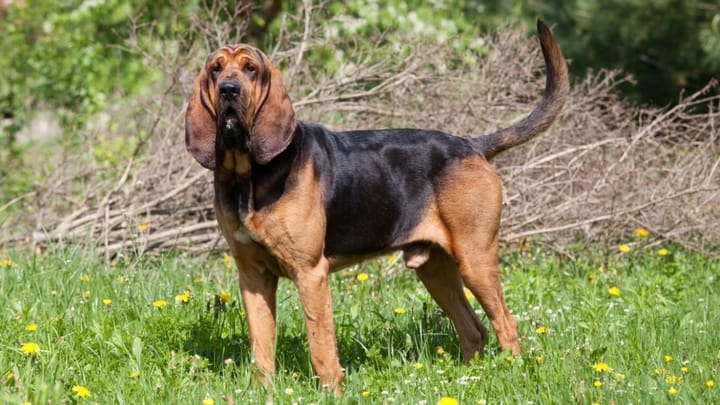Bloodhound
Other names : Chien de Saint-Hubert, St. Hubert Hound


Their name may suggest otherwise, but the Bloodhound is perhaps one of the friendliest, most gentle and most affectionate dog breeds in the whole world.
Amazing with kids, loving towards pretty much every human or animal they come across and eager to please their owners - we’d call them the perfect family dog!
Plus, we can’t forget the Bloodhound’s incredible talents - this breed is famous for their nose! They’re regularly used in the security and police world as scent detection assistants. As they say, ‘no nose knows like the Bloodhound’s nose’!
|
Life expectancy |
The Bloodhound has a life expectancy of between 10 and 12 years |
|
Temperament |
|
|
Size |
Large
|
|
Adult size |
Female
Between 23 and 26 in
Male
Between 25 and 28 in
|
|
Adult weight |
Female
Between 88 and 106 lb
Male
Between 101 and 119 lb
|
|
Coat colour
|
Black Red |
|
Type of coat
The Bloodhound’s coat is short and smooth. They boast a short, flat, dense, double and highly waterproof coat. |
Short Hard |
|
Eye colour
The Bloodhound’s eyes normally complement the colour of the coat and can be seen in hazel, various shades of brown and deep yellow colours. |
Brown
|
|
Purchase price |
The Bloodhound costs between £760 and £1075 |
Experts believe that the Bloodhound has around 250-300 million receptors in its nose, which is the most of any dog breed!
More details about the Bloodhound
Bloodhound: Origins and history
The Bloodhound is believed to originate from the St.Hubert hound, dating back as far as the Middle Ages. The breed was famed for accompanying royals on hunting trips, thanks to its renowned sense of smell. Numerous hound breeds from Europe, however, have blended together to create the sweet-natured giant we know and love today.
Physical characteristics of the Bloodhound
You can’t mistake a Bloodhound! This breed is best known for their wrinkly head and face, extremely loose skin and extra long ears - you either love it or hate it! They’re a huge breed with significant strength and power - the perfect example of a ‘gentle giant’!
They’ve got a long, sad-looking face with lots of pronounced folds. Their nostrils are large (hence their impressive sense of smell) and medium-sized, drooping, sunken eyes. The tail is long and set high.
FCI classification of the Bloodhound
-
Group 6 - Scent hounds and related breeds
-
Section 1 : Scent hounds
Bloodhound: Characteristics
Bloodhound: Behaviour
Training a Bloodhound
Well-trained Bloodhounds make for the perfect family pet - it’s just getting to that point which is the problem! Their prominent independent and stubborn streak means they can be a little tricky to train - it’s a classic case of ‘my way or the highway!’.
It’s not impossible, though - with patience, persistence and plenty of positive reinforcement, a Bloodhound will eventually learn who’s boss. If you really struggle, it’s probably best to head to a doggy obedience class. Gaining a strong recall is especially important with this breed.
Thankfully, once they’ve started picking things up, they quickly turn into a well-behaved, calm, obedient pooch.
Bloodhound: Lifestyle
Breed compatibility Bloodhound
Bloodhound: Purchase price
This breed doesn’t come cheap! You’re looking at at least £760 for a Bloodhound and if the dog is registered at the Kennel Club they can cost approximately £1075.
Average cost care: £50-£70 (this includes food, grooming, and other expenses)
Bloodhound: Shedding
Average
This one is a definite shedder! Expect to have the vacuum out regularly. Brushing can help minimize this.
Bloodhound: Grooming
The Bloodhound’s coat is low-maintenance and only needs brushing around once or twice a week, as well as a wipe down if they’ve got a little grubby.
The difficult part of Bloodhound grooming, though, is their wrinkles. They need thorough cleaning and drying, otherwise, they can easily become infected.
If you decide to adopt a Bloodhound, be prepared to wipe their face clean after every meal and drink of water. You’ll need to clean between wrinkles a few times a week using a gentle, damp cloth or wipe. Make sure to dry them thoroughly - left wet, bacteria will spread fast.
Thankfully, this breed doesn’t need to be bathed all that often - especially if they’re regularly wiped down and brushed. The Bloodhound is particularly prone to ear infections, so make cleaning and checking them a habit. As for the rest, it’s regular grooming - nails need to be trimmed every couple of weeks and teeth should be brushed as often as possible.
Bloodhound: Health
10-12 years
The Bloodhound is mighty - these giant, strong, sturdy dogs are powerful and adaptable.
This breed doesn’t cope well with hot weather. If temperatures sore, keep them indoors in a cool, dark room if possible. If you head out for the day, remember to provide regular shade breaks for your Bloodhound, as well as carrying around a constant supply of water.
Larger dogs such as the Bloodhound do tend to tolerate cold weather better than smaller breeds. However, the Bloodhound won’t fare well in extremes of cold, especially if they’re domesticated - keep them indoors, especially at night, if temperatures drop significantly.
Obesity isn’t a huge problem in the Bloodhound breed. However, they can be greedy - don’t give them too many treats or human foods!
- Bloat
- Cancer, especially lymphosarcoma
- Orthopaedic diseases
- Luxating patella
- Ear infections
- Hyperthyroidism
- Heart disease
- Epilepsy
- Eye diseases







